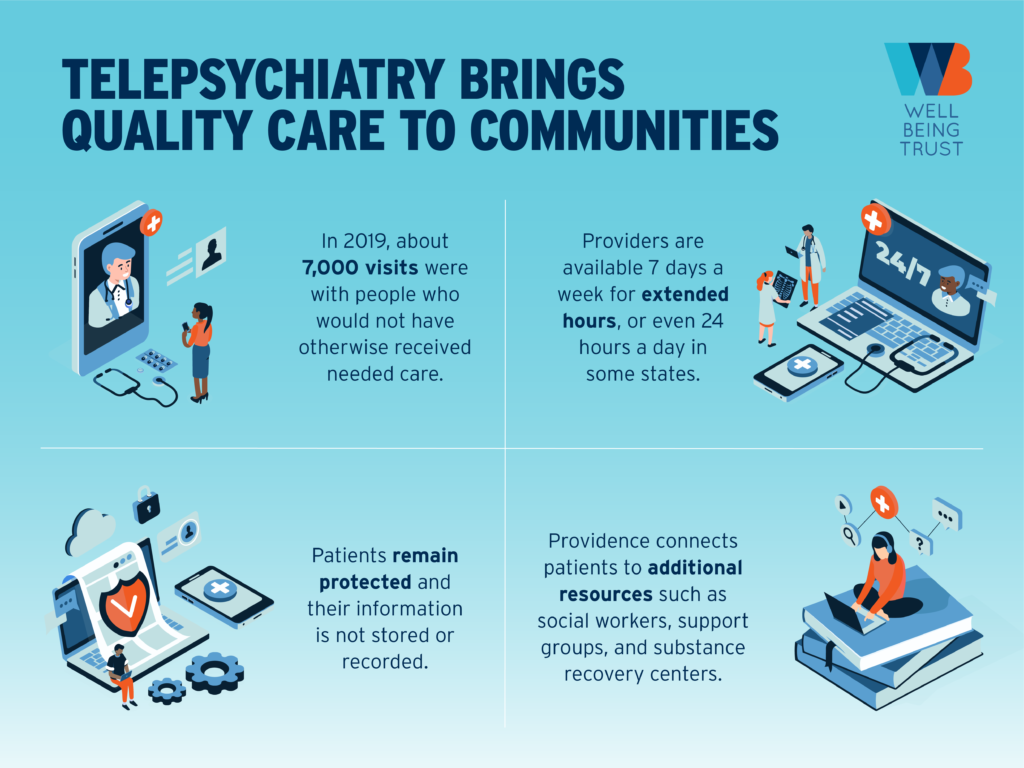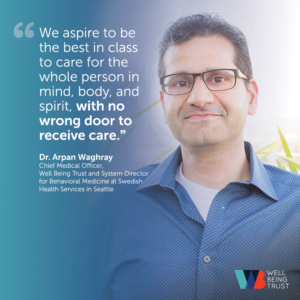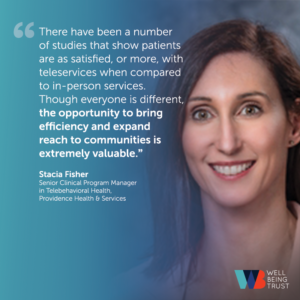Telepsychiatry bridges gaps in access to mental health care
How Providence St. Joseph Health and Well Being Trust are bringing care to communities
Three years ago, patients at several Providence Saint Joseph Health’s emergency departments had to wait more than five hours — 
“Patients would be stuck in the emergency departments for so long waiting to see a psychiatrist,” said Patrick Lee, product director of telepsychiatry and tele-behavioral health at Providence St. Joseph Health. Not only were delays difficult for those waiting, they also kept some patients who needed help from even coming in at all, he said.
Lee and other health care leaders at Providence said a revolution in telehealth is helping them not only increase access to behavioral health care, but also improve it. Both steps are necessary in a nation where mental health problems are both widespread and undertreated. Nearly 1 in 5 U.S. adults has a behavioral health condition, and yet 60% of U.S. counties have no practicing psychiatrists to support those in need of care. And while 6% to 12% of emergency department visits are related to a behavioral health concern, many hospitals are not equipped to support these patients.
Identifying more and better care as a need in its own health care facilities, Providence has grown a telehealth model over the past several years to provide psychiatric access to 32 community hospitals and emergency departments in four states.
Mission to improve care
Providence’s telepsychiatry program went live near the end of 2017, starting with small critical access hospitals in Eastern Washington, and has since expanded to cover hospitals and emergency departments in California, Washington, Alaska and Oregon. Last year, about 7,000 visits were with people who would not have otherwise received needed care.
When the hospital requests a consult, they are connected with a remote provider almost immediately who will talk to the hospital’s physicians about the patient and gather additional history and information This is then followed by a comprehensive psychiatric assessment using a secure video call with the patient to begin the treatment plan.
The program is part of a larger initiative to improve access to compassionate behavioral health care by meeting people where they are 
“We aspire to be the best in class to care for the whole person in mind, body and spirit, with no wrong door to receive care,” said Dr. Arpan Waghray, chief medical officer for Well Being Trust and Executive director for behavioral medicine at Providence’s Swedish Health Services in Seattle.
First, leaders had to identify the gaps. Providence supports 51 hospitals and emergency departments spanning seven states — many in rural, underserved areas — so they scanned the system’s entire footprint to identify areas where there was no access to psychiatric care, often due to geography and resource constraints.
Stacia Fisher, a senior clinical program manager of tele-behavioral health at Providence, led the health system’s efforts and built an integrated care team made up of clinical social workers and board-certified psychiatrists. Each team member is trained to care for patients not only in emergency departments, but on the medical surgical floors of hospitals, too.
Today, Providence has two panels of providers. In California, the team is available 24 hours a day, 7 days a week. In other regions, providers are available 7 a.m.–7 p.m. every day.
“There have been a number of studies that show patients are as satisfied, or more, with teleservices when compared to in-person services,” Fisher said. “Though everyone is different, the opportunity to bring efficiency and expand reach to communities is extremely valuable.”
Navigating the road to telepsychiatry
Though the team at Providence has made strides over the last three years to improve access to necessary care using new technologies, integrating online care into brick-and-mortar hospitals and emergency departments is no easy feat.
Access to technology, for example, has been one obstacle. Many of the hospitals in need of telepsychiatry services are in rural areas with outdated buildings, so connecting to new technologies and ensuring internet quality can be a challenge.
Another challenge has been licensing and credentialing providers. “Historically, the practice of medicine has been localized, and so 
Telehealth is still relatively new, so easing people into a culture of delivering care through new modalities will take time. Remote providers don’t have the same opportunities to build relationships with colleagues on the ground, which is an essential component of team-based models of care, and they are often unfamiliar with the regions they are serving, making it difficult for them to point patients to valuable local resources, Waghray said.
To bridge this gap in information, Providence created provider “handbooks” that outline resources — such as social workers, support groups, and substance recovery centers — available in the areas served by telehealth, which providers can use to make recommendations to patients.
Patients, too, need to acclimate to the culture shift. Providence takes many steps to ensure that patients feel comfortable with receiving care digitally, such as acquiring consent, assuring patients that the service is confidential and their information will not be stored or recorded, and collecting feedback on their experiences to improve the service.
Moving forward, Providence hopes to build on the success so far and use data — such as how long patients remain in the emergency department and how often patients are readmitted for the same concerns — to inform next steps.
“Right now, we are solving the immediate problem, which is a shortage of psychiatrists in our hospitals and communities,” Lee said. “But if we want to make a greater impact, we have to focus on improving outcomes and catching patients before they come into the emergency departments.”






